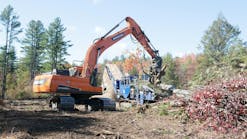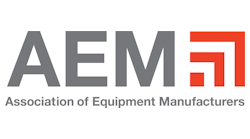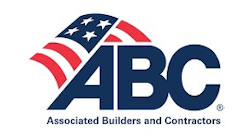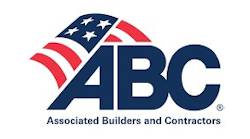Until recently, hydraulic pilot controls were considered the state of the art for skid-steer loaders. Pilot controls on joysticks hydraulically actuate the main hydraulic systems of a piece of mobile equipment. Such devices offer sensitive control due to low actuating forces and proportional control behavior. They’re much less fatiguing for an operator than earlier, mechanical controls (still favored by some), and they offer a long, maintenance-free
service life.
But now, Caterpillar, John Deere, and Bobcat have begun to offer electro-hydraulic controls. “We use drive-by-wire technology,” says Gregg Zupancic, product marketing manager for skid-steer loaders at John Deere Construction and Forestry Division. With electro-hydraulic controls, the joystick is linked by wires to an electronic control unit (ECU)-the brains of the control. Other wires connect the ECU to the actual hydraulic valves that control movements of the machine and boom and bucket.
“You’ll see the industry move to electro-hydraulic controls, mainly because of expandability,” says Zupancic. “You can program more things. You can slow down the boom and bucket speed, or you can slow down the wheel speed. You can make the wheels max out at 30% of top speed, if you want to, for creeper control in slow-moving operations. Or you can program the boom to go to a certain height and stop. That’s a function of electro-hydraulic controls.”
A Volvo skid steer works over hard stone with an attachment in place.
The disadvantage of hydraulic pilot controls, says Zupancic, is that you cannot expand the functions of the control system unless you add more hydraulic lines or have more ports in your hydraulic valve.
John Deere and others still offer mechanical linkage, with which one’s feet control the boom arms and bucket-and levers control the driving functions. “But for about $2,500 more you can get pilot controls or electro-hydraulic controls, and you don’t have to fight those levers all day long,” says Zupancic. “And with electro-hydraulic controls you can change the control pattern. We can configure the steering and boom and bucket controls to suit the operator. You can drive with one hand or two.”
Three Systems From Bobcat
“Contractors have a choice of control options on many models of Bobcat skid-steer loaders when making a purchase decision,” says Mike Fitzgerald, loader product specialist, Bobcat Co. “The standard controls offered on all models were invented by Bobcat and remain one of the most popular control styles today.”
With standard controls, dual levers control the drive functions while dual foot pedals control the lift and tilt functions. Also available on select models is the Advanced Control System (ACS). The ACS offers two control styles in one, and the operator can choose between standard controls or H-pattern hand controls. The Selectable Joystick Controls (SJC) option is the third control method offered by Bobcat. The SJC option allows operators to switch between two hand-control patterns, H-pattern or ISO.
Komatsu uses the same proportional pilot control system on skid-steer loaders as on its larger construction equipment. “We find no benefit in electro-hydraulic controls for skid-steer loaders,” says Bob Beesley, product manager for skid-steer loaders and compact track loaders at Komatsu America Corp. “Pilot proportional controls make a machine more controllable than electric-over-hydraulic systems and are a vast improvement over mechanical/servo controls.”
Radial Lift and Vertical Lift
A perennial issue with skid-steer loaders is radial lift versus vertical lift. Major manufacturers offer both, but the difference is important. Bobcat, for example, offers both. “We recognize that contractors may benefit from one design or the other and offer both to best fit the applications being performed by different customers,” says Fitzgerald.
“A radial machine will dig a lot better; it will dig in hard soil, because you get about 30% more weight at the cutting edge on a radial lift machine. Plus, the radial lift arm arrangement is also stronger and will stand more abuse than a vertical lift machine.” says Beesley. “Of course, the vertical lift machine is more productive in lift and loading applications and is preferable in many applications. The decision of which type machine will be most productive is application driven. The better the application is understood, the more likely the machine can be matched to the job.”
Vertical lift machines do have more lifting capacity for the same size machine. “We offer both radial and vertical lift,” says Deere’s Zupancic. Deere offers seven models of skid-steer loaders, ranging from the 45-horsepower Model 313 to the 85-horsepower Model 332. The two smallest models are radial lift machines, and the remaining five are vertical lift units.
John Deere uses a wheelbase that’s a little wider-for increased stability-compared to non-Deere machines, says Zupancic. Plus, the Deere’s weight distribution is a little different. “Our weight is 60% in the rear and 40% in the front, so when you load it up, you get close to 50:50 front-to-rear weight distribution,” he explains.
With the launch of its M-Series loaders in the summer of 2009, Bobcat now offers 14 models of skid-steer loaders.
Bobcat’s New Lineup
With the launch of its M-Series loaders in the summer of 2009, Bobcat now offers 14 models of skid-steer loaders, including the new S630 and S650 models. The company’s skid-steer loader models range from 23.5 horsepower in the little S70 with a 700-pound-rated operating capacity to 85 horsepower in the S330 with 3,300-pound-rated operating capacity.
With the launch of the new M-Series skid-steer loaders, Bobcat introduced some of the most significant design changes undertaken by the company to date. The first model available is the S630 skid-steer loader, followed by the S650, with additional models to follow.
Some of the new features and benefits of the M-Series include:
- Unique cab-forward design brings the operator closer to the work area and provides better overall visibility.
- Larger door improves visibility and makes entry and exit of the machine easier.
- Increased size of windows offers better visibility on the sides, rear and top of the machine.
- Pressurized cab keeps the operator and cab interior clean.
- New engine mounts reduce vibration and decrease noise.
These changes along with other improvements help reduce noise in the cab by more than 60%. Greater availability of adjustments to the seat accommodates operators of different sizes. The joysticks on models with Selectable Joystick Controls move up-and-down with the seat. Higher standard flow and pressure on hydraulic system increases productivity. Removable hydraulic hose guides protect hoses and make changing and routing attachment hoses easier.
Tractive effort, too, has been increased 15%-20%. Hydraulic couplers have been mounted on the front plate to protect hoses and couplers from damage, and the lower rear frame extends out beyond the tailgate, protecting the rear of the loader from obstacles and scrapes and bumps. Maintenance has been simplified by with an easy-to-read hydraulic sight gauge and end-greased pivot pins.In October 2007, Caterpillar introduced its new B2 Series of skid-steer loaders and multiterrain loaders. Six skid-steer loaders are included in the B2 Series: the 216B2, the 226B2, the 232B2, the 242B2, the 236B2 and the 252B2. The two new track loaders are the 247B2 and the 257B2. Rated operating capacities range from 1,400 pounds on the 216B2 up to 2,500 pounds on the 252B2.
Options are bundled in packages to make selection easier. For the B2 Series machines, cab packages allow selection ranging from a basic cab to one with a suspension seat, cab debris barrier, cup holder, heater/air conditioner, cab door, and side windows.
A Gehl V270 achieves near-vertical lift.
Three available control packages run from basic design to one with high-flow joystick options. The latter option allows actuation of continuous hydraulic flow from a button on the joystick. An auxiliary hydraulic flow toggle on the right joystick allows precise control of flow to the work tool.
On the 236B2 and 252B2, a two-speed option is actuated by a trigger on the left joystick. That option allows the operator to increase productivity in an application where high travel speeds are needed.
Caterpillar says the radial lift design on four of the machines delivers excellent digging performance. Other models have a vertical lift design, which provides extended reach and lift height for quick-and-easy truck loading.
In August 2008, Caterpillar introduced three new models of compact track loaders as additions to its lineup of rubber track loaders. The new loaders-the 277C, the 287C and the 297C-feature durable, steel embedded track and steel undercarriage components for maximum life in aggressive applications. All three models feature two-speed drive systems, with a maximum speed of 8.5 miles per hour, for rapid movement around large job sites.The electro-hydraulic joystick control of the drive motors on the three Cat loaders delivers straight-line tracking, and electronic torque management optimizes productivity. The new models have operating capacities of 3,200, 3,850, and 4,150 pounds at 50% of tipping load.
Volvo Construction Equipment offers five skid-steer loaders, and they’re all radial lift models, says Dan Rafferty, product specialist for skid-steers. “It’s a simple system, a very strong system with no extra arms or cantilevers,” says Rafferty. “And it’s very easy to maintain.”
Volvo’s skid-steers range from the 45-horsepower MC60B up to the 81-horsepower MC110B. The company offers either manual control or hydraulic pilot control on all five models. The pilot controls feature a short throw and low effort, for less operator fatigue at the end of the day. The cab has a heater and air conditioner as options.
Six skid-steer loaders are included in Caterpillar’s B2 Series: the 216B2, the 226B2, the 232B2, the 242B2, the 236B2, and the 252B2.
John Deere and others still offer mechanical linkage, with which one’s feet control the boom arms and bucket-and levers control the driving functions-although electro-hydraulic controls are available.
“We have excellent visibility,” says Rafferty. “With skid-steer loaders, if you can’t see it, you’re going to hit it. So we take extra care to make sure our visibility is at the head of the class.”
New From Case
In January of 2008, Case unveiled its new 400 Series 3 line of skid-steer loaders. The new machines feature more powerful engines, a redesigned cab and improved serviceability for all models. Tier III certified engine power is now available on the Case 410, 420, 430, 435, 440, 445, and 465 skid steers.
Net horsepower for the line ranges from 57 to 83 horsepower-marking horsepower increases across the board. The 410 Series is powered by an ISM 2.2-liter turbocharged engine. The 420, 430, 435, and 445 Series 3 machines boast Case 3.2-liter turbocharged engines. And the 440, 450, and 465 Series 3 skid-steer loaders are powered by a 4.5-liter turbocharged Case engine.
“Operator comfort is a big factor in productivity,” says Jim Hughes, marketing manager, Case Construction Equipment. “That’s why Case is always striving to improve the cab and operator’s platform when designing new models.”
The new cabs for all Case Series 3 models feature a 7% increase in headroom and a 6% increase in lap-bar width, along with improved visibility all around. The 435, 445, 450, and 465 Series 3 models offer a 20% increase in front-glass area, while the 410, 420, 430, and 440 Series 3 units record a whopping 81% increase in front glass area.
Also in January 2008, Case introduced its new 400 Series 3 line of compact track loaders, which feature Tier III-certified engines with increases in horsepower for all four models. Pilot controls are now standard for all four Case Series 3 machines, the 420CT, the 440CT, the 445CT, and the 450CT. With the new models Case is also offering a new cab, with improved visibility and ergonomics.
New From Gehl
Last February, Gehl Co. announced the all-new V270 skid-steer loader. With a powerful 84-horsepower Yanmar turbodiesel and a rated operating capacity of 2,700 pounds, Gehl says the V270 is among the strongest in its class. The V270 achieves near-vertical lift with a state-of-the art lift arm design that provides extended reach and lift height for easy truck loading.
With more than 130 inches of lift height, the V270 has among the highest lift reaches in its class. Equipped with an electronic engine control and a foot throttle, the V270 can be operated at part throttle for lower sound levels and reduced fuel consumption.
Superior comfort is provided in an all-new, ergonomic cab design for the V270. The optional, pressurized sealed cab enclosure provides a cleaner and quieter operating environment. Fully adjustable controls and an optional air-ride seat deliver outstanding comfort.
As an option, Gehl offers a 36.9-gallons-per-minute high-flow auxiliary hydraulics system to handle virtually any high-performance attachment. And the standard-equipment, infinitely adjustable proportional auxiliary hydraulic control gives the operator the ability to adjust attachment speeds for optimum performance and efficiency.
Across the board, these skid-steer loaders and compact track loaders are better-designed than ever. So have a look! Check them out at your local equipment dealers.








